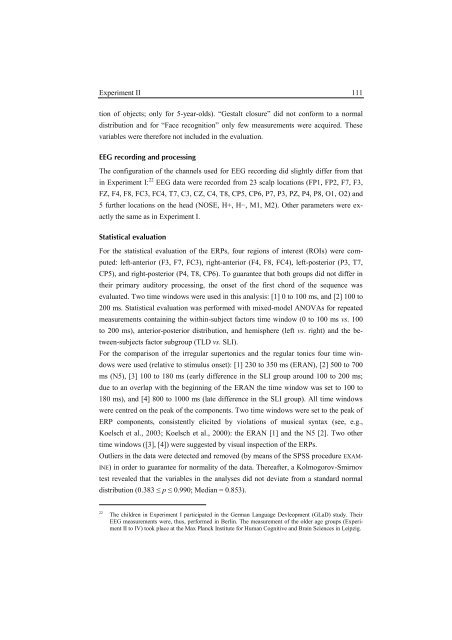Neural Correlates of Processing Syntax in Music and ... - PubMan
Neural Correlates of Processing Syntax in Music and ... - PubMan
Neural Correlates of Processing Syntax in Music and ... - PubMan
You also want an ePaper? Increase the reach of your titles
YUMPU automatically turns print PDFs into web optimized ePapers that Google loves.
Experiment II 111<br />
tion <strong>of</strong> objects; only for 5-year-olds). “Gestalt closure” did not conform to a normal<br />
distribution <strong>and</strong> for “Face recognition” only few measurements were acquired. These<br />
variables were therefore not <strong>in</strong>cluded <strong>in</strong> the evaluation.<br />
EEG record<strong>in</strong>g <strong>and</strong> process<strong>in</strong>g<br />
The configuration <strong>of</strong> the channels used for EEG record<strong>in</strong>g did slightly differ from that<br />
<strong>in</strong> Experiment I: 22 EEG data were recorded from 23 scalp locations (FP1, FP2, F7, F3,<br />
FZ, F4, F8, FC3, FC4, T7, C3, CZ, C4, T8, CP5, CP6, P7, P3, PZ, P4, P8, O1, O2) <strong>and</strong><br />
5 further locations on the head (NOSE, H+, H�����������������������������������xactly<br />
the same as <strong>in</strong> Experiment I.<br />
Statistical evaluation<br />
For the statistical evaluation <strong>of</strong> the ERPs, four regions <strong>of</strong> <strong>in</strong>terest (ROIs) were computed:<br />
left-anterior (F3, F7, FC3), right-anterior (F4, F8, FC4), left-posterior (P3, T7,<br />
CP5), <strong>and</strong> right-posterior (P4, T8, CP6). To guarantee that both groups did not differ <strong>in</strong><br />
their primary auditory process<strong>in</strong>g, the onset <strong>of</strong> the first chord <strong>of</strong> the sequence was<br />
evaluated. Two time w<strong>in</strong>dows were used <strong>in</strong> this analysis: [1] 0 to 100 ms, <strong>and</strong> [2] 100 to<br />
200 ms. Statistical evaluation was performed with mixed-model ANOVAs for repeated<br />
measurements conta<strong>in</strong><strong>in</strong>g the with<strong>in</strong>-subject factors time w<strong>in</strong>dow (0 to 100 ms vs. 100<br />
to 200 ms), anterior-posterior distribution, <strong>and</strong> hemisphere (left vs. right) <strong>and</strong> the between-subjects<br />
factor subgroup (TLD vs. SLI).<br />
For the comparison <strong>of</strong> the irregular supertonics <strong>and</strong> the regular tonics four time w<strong>in</strong>dows<br />
were used (relative to stimulus onset): [1] 230 to 350 ms (ERAN), [2] 500 to 700<br />
ms (N5), [3] 100 to 180 ms (early difference <strong>in</strong> the SLI group around 100 to 200 ms;<br />
due to an overlap with the beg<strong>in</strong>n<strong>in</strong>g <strong>of</strong> the ERAN the time w<strong>in</strong>dow was set to 100 to<br />
180 ms), <strong>and</strong> [4] 800 to 1000 ms (late difference <strong>in</strong> the SLI group). All time w<strong>in</strong>dows<br />
were centred on the peak <strong>of</strong> the components. Two time w<strong>in</strong>dows were set to the peak <strong>of</strong><br />
ERP components, consistently elicited by violations <strong>of</strong> musical syntax (see, e.g.,<br />
Koelsch et al., 2003; Koelsch et al., 2000): the ERAN [1] <strong>and</strong> the N5 [2]. Two other<br />
time w<strong>in</strong>dows ([3], [4]) were suggested by visual <strong>in</strong>spection <strong>of</strong> the ERPs.<br />
Outliers <strong>in</strong> the data were detected <strong>and</strong> removed (by means <strong>of</strong> the SPSS procedure EXAM-<br />
INE) <strong>in</strong> order to guarantee for normality <strong>of</strong> the data. Thereafter, a Kolmogorov-Smirnov<br />
test revealed that the variables <strong>in</strong> the analyses did not deviate from a st<strong>and</strong>ard normal<br />
distribution (0.383 ��p ����������edian = 0.853).<br />
22 The children <strong>in</strong> Experiment I participated <strong>in</strong> the German Language Devleopment (GLaD) study. Their<br />
EEG measurements were, thus, performed <strong>in</strong> Berl<strong>in</strong>. The measurement <strong>of</strong> the older age groups (Experiment<br />
II to IV) took place at the Max Planck Institute for Human Cognitive <strong>and</strong> Bra<strong>in</strong> Sciences <strong>in</strong> Leipzig.












